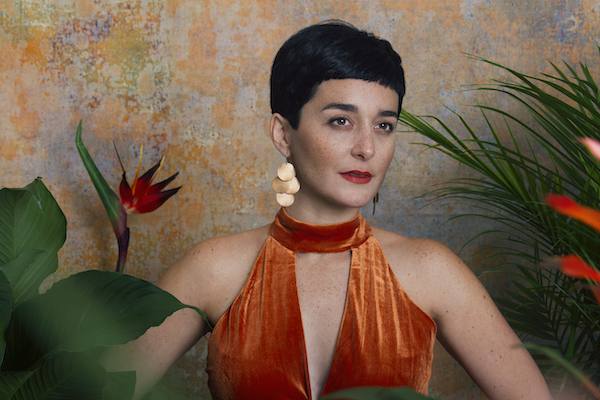Oct 28, 2025 10:47 AM
In Memoriam: Jack DeJohnette, 1942–2025
Jack DeJohnette, a bold and resourceful drummer and NEA Jazz Master who forged a unique vocabulary on the kit over his…

Camila Meza is among the 25 artists DownBeat thinks will help shape jazz in the decades to come.
(Photo: Rachel Thalia Fisher)Singer and guitarist Camila Meza was slightly anxious when, as a 19-year-old jazz novice, she took the stage for her debut at Thelonious, a top club in her native Santiago, Chile. But as she worked her way through a set of standards, she grew calmer. By the end of the night, she had found a home.
“I was [thinking], ‘OK, this is it,’” she said in August, her searching eyes framed by the screen in a Zoom transmission from a lush site in Montana, where she had been holed up for five months because of the pandemic.
Meza, 35, seemed at home in Big Sky country—a setting that recalled the hills around Santiago, where she frolicked gamely in a video shot in February 2019 for “Kallfu,” the striking opening track on her breakthrough album, Ámbar (Sony Masterworks).
She reflected on the distance she had traveled, artistically and geographically, since that Thelonious gig. In 2007, she released Skylark, followed by two more collections of others’ tunes, Retrato (2009) and Prisma (2013).
Traces (2016), her first full-scale presentation of her own music, won two Independent Music Awards. But even as she was preparing to release that album, she was thinking about material for Ámbar, which, by involving a contemporary string quartet, transformed her sound.
“It is a record,” she explained, “that is ambitious in a way that, ‘Yes, I’m going to write my own songs and arrangements, but I’m also going to explore new orchestrations and new ways of expressing certain emotions and journeys within the music.’”
On “Kallfu,” she integrates primal vocals and nimble guitar work with a jazz trio and the string quartet, which, by turns, drives the rhythm in minimalist fashion and breaks the rhythm with aleatoric invention.
In Meza’s music, poignant explorations of sadness are offset by an occasional joyful noise. “Kallfu,” she said, was intended to do just that for Ámbar by introducing a “song that was in the brighter spectrum.”
In “Portal,” an extended composition she hopes to record, she expresses both sides of her musical personality. Employing fresh instrumentation—a harp, electronics and additional singers join her voice, guitar and piano-bass-drums trio—this highly textured work evokes both the near-apocalypse and ultimate salvation. Premiered in June 2019 as part of The Jazz Gallery’s commission series, its theme has special resonance these days.
“One of the very clear learnings of this time is to be able to let go of certain things, like attachments to whatever you think life should be,” she said. “We had a beautiful year last year and now, after a few months of not feeling creative—I was pushing myself through these emotional waves of feeling good and feeling bad—I’m starting to feel renewed energies to just speak for the moment.” DB
This story originally was published in the November 2020 issue of DownBeat. Subscribe here.

Jack DeJohnette boasted a musical resume that was as long as it was fearsome.
Oct 28, 2025 10:47 AM
Jack DeJohnette, a bold and resourceful drummer and NEA Jazz Master who forged a unique vocabulary on the kit over his…

D’Angelo achieved commercial and critical success experimenting with a fusion of jazz, funk, soul, R&B and hip-hop.
Oct 14, 2025 1:47 PM
D’Angelo, a Grammy-winning R&B and neo-soul singer, guitarist and pianist who exerted a profound influence on 21st…

To see the complete list of nominations for the 2026 Grammy Awards, go to grammy.com.
Nov 11, 2025 12:35 PM
The nominations for the 2026 Grammy Awards are in, with plenty to smile about for the worlds of jazz, blues and beyond.…

Flea has returned to his first instrument — the trumpet — and assembled a dream band of jazz musicians to record a new album.
Dec 2, 2025 2:01 AM
After a nearly five-decade career as one of his generation’s defining rock bassists, Flea has returned to his first…

Drummond was cherished by generations of mainstream jazz listeners and bandleaders for his authoritative tonal presence, a defining quality of his style most apparent when he played his instrument unamplified.
Nov 4, 2025 11:39 AM
Ray Drummond, a first-call bassist who appeared on hundreds of albums as a sideman for some of the top names in jazz…





